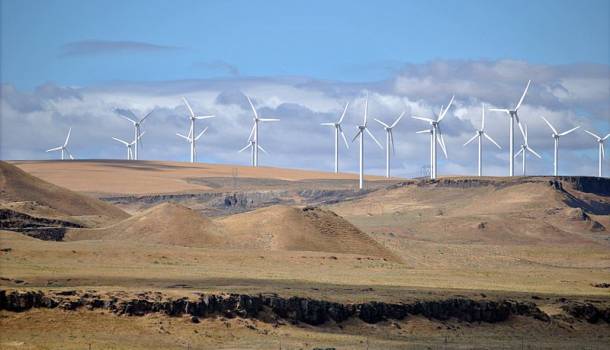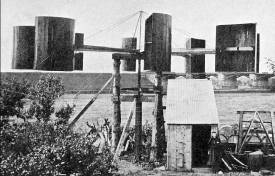Some of us have already seen the wind farms that have been popping up across the United States. They are becoming more popular as wind power technology continues to advance. Wind power is the process when wind energy is converted into mechanical energy (energy that is useful) through the use of wind turbines, wind mills, and wind pumps.

Shepherds Flat Wind Farm, Oregon, USA (Photo credit: Wikipedia)
The wind turbine is also known as a wind power plant, and it is the giant white tower you see with three blades spinning. Wind mills, wind pumps, and wind turbines all convert kinetic energy into mechanical energy for different uses. Common ways that wind power is used in agriculture is to charge batteries, grind grain, and even pump water. Our ancient ancestors used wind in much the same way, though obviously wind turbine technology has come a long way.
When comparing wind power to the use of fossil fuels the difference is night and day. Wind power is plentiful, renewable, distributed widely, and produces no greenhouse gas emissions during use.
Wind Power for Agriculture

One of the earlier wind turbines from 1891
Wind power was first used by farmers in America back in the late 1800s to early 1900s. They used wind to pump water and generate power that could grind grain.
The fastest growing renewable energy source is wind power because of its simplicity and cost reductions. Many people across the world can benefit from the use of wind power, but farmers benefit the most directly because of the quick economic boost that it provides.
Farmers are in a unique position where they have the land and space for a wind farm, and they also benefit the most from the energy. It is not hard for them to find a wind developer that would want to lease their land if it’s in a good location.
Advantages and Disadvantages of Wind Energy
With so many different avenues we can take to use the energy that wind produces, you wonder why as a country we haven’t gone full force towards it. There are cons of wind energy that are holding certain advancements back. Here’s a look at of some of the pros and cons of wind power:
Advantages of Wind Energy
- It is clean and no fuel is used to convert the wind into energy, therefore there is no pollution created in the process.
- Renewable and sustainable, there is simply no way to run out of it.
- Costs are continuing to decrease as we advance in research
- There is an abundant supply in the United States and in the rest of the world there is enough space to generate 20 times the amount of power than the entire human population needs.
- Once the infrastructure is paid for, power can be generated at nominal cost
Operational Efficiency
Wind turbines are very cheap to maintain and operate once they are installed. Once the turbine pays for itself with the energy that it produces, everything else is literally profit or “gained” energy.
All we have to do is improve our research and placement of the wind turbines to ensure that there is enough wind to make the turbine spin. Improper placement is something that is discussed in the disadvantages section below.
Residence Potential
A homeowner can put a wind turbine on their land to reap several of the rewards that wind energy offers. The wind turbine will produce enough energy to power the entire house and also protect it from power outages.
If a homeowner has a lot of extra land available, they may even consider leasing it out to a wind developer who will pay a pretty penny to make use of it.
Disadvantages of Wind Energy

Off shore wind turbines
Wind is inconsistent, unsteady, and unpredictable on a short term basis. From a year-by-year standpoint, it is much easier to estimate and study the potential of wind power. We need to hope for breakthroughs in the capabilities of storing energy for later use.
The installations of wind power equipment are expensive and rely heavily on large government subsidies to remain competitive and profitable. Advancements in technology and research will improve this to make it more reasonably cost effective.
People consider wind farms to be an eye sore. Not only this, but the noise is said to be pretty unbearable if you live close to a wind turbine.
Wind farms can have an impact on wildlife. Some ecologists have come out to talk about this, saying that the turbines are killing rare species of birds and bats.
Improper Placement and Exaggerated Energy Claims
Experts say that wind developers are grossly exaggerating the amount of energy that they think a wind farm would product in a given area. They are simply seeking large investments and subsidies so that they can follow through with their large projects. These experts point out that this is slowing down the potential of wind power because we should be putting wind farms in areas where it is significantly windy and can produce enough energy to make back the money from the initial investment.
Aesthetics and Wildlife Threat
Some people - especially local residents - often express their concerns with how wind turbines look. Wind turbines can be built outside of urban territories in order to minimize the issue, but it may still upset local residents in rural areas. Wind energy’s footprint is still microscopic in comparison to the environmental footprint left behind from energy produced through the burning of fossil fuels.
There also used to be an issue with wind turbines creating a lot of noise for those who live in proximity, although these noises have been significantly reduced with new advancements of technology and better placement choices.
Some environmentalists are quite zealously propagating the idea that birds and bats are being affected by the production of wind farms. This problem may seem small to some people but not to some British ecologists who say that wind power is devastating the populations of rare birds and bats.
Looking at the statistics, the number of birds that are killed by the turbines is tiny compared to the amount of birds that die daily by flying into buildings. Do the benefits of wind energy outweigh the negatives? Anyone interested in this issue is encouraged to do further independent research in order to draw their own conclusions.